Catalogue > List by artist
Browse the entire list of Rencontre Internationales artists since 2004. Use the alphabetical filter to refine your search. update in progress
Claire Denis
Claire Denis
Catalogue : 2019High Life | Fiction | 4k | color | 110:0 | France | 2018
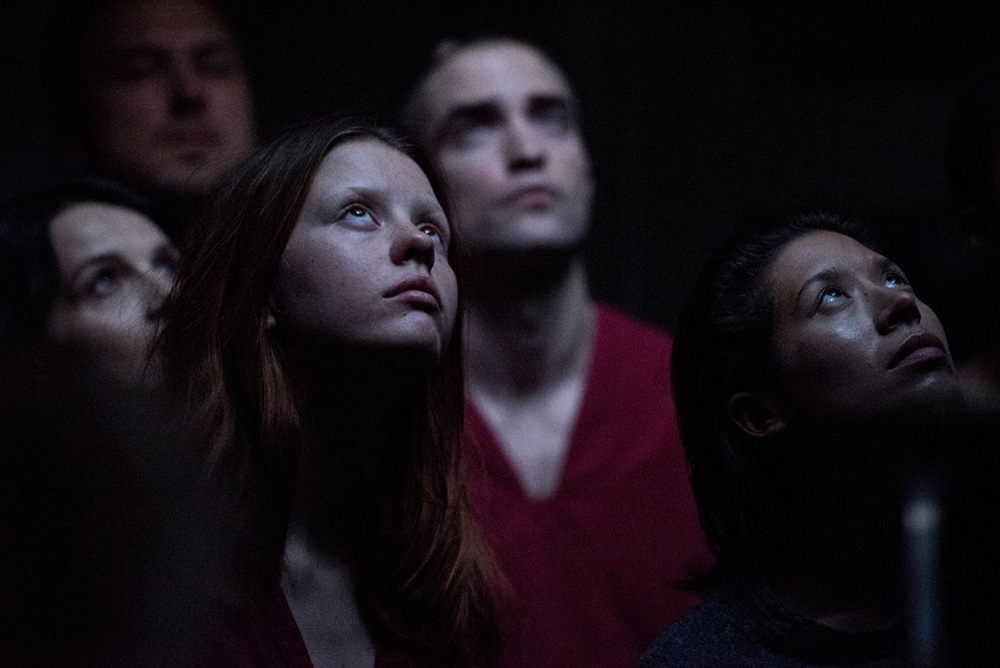
Claire Denis
High Life
Fiction | 4k | color | 110:0 | France | 2018
Deep space. Monte and his daughter Willow live together aboard a spacecraft, in complete isolation. A man whose strict self-discipline is a shield against desire, Montefathered her against his will. His sperm was used to inseminate the young woman who gave birth to her. They were members of a crew of prisoners –death row inmates. Guinea pigs sent on a mission. Now only Monte and Willow remain. Through his daughter, he experiences the birth of an all-powerful love. Together, father and daughter approach their destination –the black hole in which time and space cease to exist.
Claire Denis is director and screenwriter, renowned for films including Chocolat, Beau Travail, Trouble Every Day, 35 Shots of Rum, and Bastards. Born in Paris, Claire Denis lived in a number of African countries until the age of 12. Having returned to France, she studied at the IDEHEC (Institut des Hautes Etudes Cinématographiques), where she met cinematographer Agnès Godard, who would later work on the majority of her films. She began her professional life in the cinema as assistant to major directors like Robert Enrico, Wim Wenders, Costa Gavras and Jacques Rivette. She later worked with Jim Jarmusch on his film Down by Law.In 1987, Claire Denis wrote and directed her first film, Chocolat. A semi-autobiographical story of racial tension in the colonial Africa of the 1950s at the moment of independence, the film premiered In Competition at the 1988 Cannes Film Festival, was nominated at the César Awards and met with widespread critical acclaim in the US. In 1996, she was awarded the Golden Leopard at the Locarno Film Festival for Nenette and Boni. Beau Travail (1999), Trouble Every Day (2001), Vendredi soir (2002), 35 Shots of Rum (2008), White Material (2009), and Bastards (2013) – presented in Un Certain Regard at the Cannes Film Festival in 2013 –, followed. In 2017, Claire Denis returned to Cannes when Bright Sunshine In, featuring Juliette Binoche, Xavier Beauvois, Nicolas Duvauchelle, Alex Descas and Gérard Depardieu, screened as the opening film in Directors’ Fortnight. Her latest film, High Life, starring Robert Pattinson and Juliette Binoche, has been released in November 2018. Claire Denis has co-written the majority of her films with Jean-Pol Fargeau, but has also collaborated on scripts with Emmanuèle Bernheim (Vendredi Soir), Marie NDiaye (White Material) and Christine Angot (BrightSunshine In).
Kieron Dennis
Catalogue : 2006oo oo wow wee (nostalgia is coming back) | Experimental video | | color | 5:0 | United Kingdom | 2004
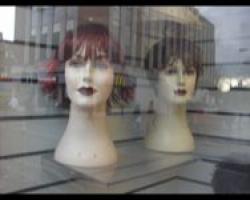
Kieron Dennis
oo oo wow wee (nostalgia is coming back)
Experimental video | | color | 5:0 | United Kingdom | 2004
"Oo oo wow wee" (nostalgia is coming back) is a expressive video poem that uses a range of acoustic and visual signs to create an experimental narrative. The film echoes a stream of consciousness where thoughts and images collide, connecting and disconnecting meaning. The video uses a complex layering of still image sequences merging subjects such as hairdresser signs, bikes and fireworks.
Shrutiman Deori, Dharmendra Prasad
Catalogue : 2025Aadara | Experimental film | 4k | color | 29:52 | India | 2024
Shrutiman Deori, Dharmendra Prasad
Aadara
Experimental film | 4k | color | 29:52 | India | 2024
When cracked seasons passes through the materials and life’s goal then how long a dream can sustain? How long urgencies can take to transfer into pleasing weathers of now? How long a season can sustain in the desertification of care? Aadara - a Bhojpuri sub season of 16 days at the time of monsoon is the beginning of the paddy plantation and rains in the Bhojpur region of India. The title is referred from the presence of season which symbolises life and dreams through cyclic toil. The work is an audio visual/seasonal conversation between the agrarian urgencies of Nadaon village in Bihar and the extracted forests and contaminated water bodies of Rani forest of Brahmaputra valley. The crucial goal of the work is to place the viewer into the friction between multi-layered fragments of times and ecologies by creating a space of contemplation.
Dharmendra Prasad- Rolling through orality, toil, winds, dimensions, horizon and deteriorating seasons and sites, Dharmendra Prasad harvests imagination, memories, times, change and toil, that are stored as residue in the backyard of life's goal. Through the medium of need, time, toil and soil Dharmendra's practice gets cultivated and tilledup in the form of installations, videos, paintings, photography, texts, events, and travelogue and beyond. Born in-between stories, discrimination, hierarchies, chaos and silence, full of winds and dusts, without any address, Dharmendra practices between the fields of Gangatic plains to the villages, water bodies and rainforests of northeast India, and in extension co-founding the Guwahati based Anga Art Collective. Shrutiman Deori is a filmmaker based out of Guwahati, North East India. He has worked on documentaries, narrative films as well as video art installations. While for the most part he works as a cinematographer, Shrutiman has also directed films that have received critical acclaim in film festivals around the world including International Documentary Film Festival Amsterdam(IDFA) and Camden international Film Festival. He is the recipient of IDFA Bertha Fund 2023 for his ongoing feature documentary "Shadows of the Forest". He works in the audio-visual medium wherein he explores the politics of indigeneity , community and environment. Shrutiman studied sound engineering from School of Audio engineering, Chennai and was also selected for the cinematography mentorship program by the Indian Society of Cinematographers(ISC).
Thomas Depas
Catalogue : 2020Hasbannium | Experimental fiction | 16mm | color | 0:0 | Belgium | 2018
Thomas Depas
Hasbannium
Experimental fiction | 16mm | color | 0:0 | Belgium | 2018
A kid on an overboard, a camgirl setting up the show, a stranger sneaking trucks, while a gamer’s spleen resonate in a virtual dungeon. Hasbannium is a series of impressionist evocations drawing elliptic sequences in a metaphorical desert, an experimental fiction which has it’s root in Hesbaye, an agricultural region in Belgium with open horizons, devoid of forests or rivers. Through these landscapes, a choral film comes into being, with figures seeking out a humanity that reinvents itself in a universe of signs and meanings that are increasingly confused. The result is an impressive evocation of the temptation to disappear in which absence to self and world sketches out granular motifs.
Bieke Depoorter, Mattias De Craene
Catalogue : 2018Dvalemodus | Experimental doc. | 4k | color | 9:0 | Belgium, Germany | 2017
Bieke Depoorter, Mattias De Craene
Dvalemodus
Experimental doc. | 4k | color | 9:0 | Belgium, Germany | 2017
In states of endless slumber, people endure the stifling dark. Powerful forces of nature rage relentlessly, sometimes soothing and sometimes menacing. The roar of the factory thunders on without halt, steadily eroding the surrounding landscape. Sluggish shapes seemingly abide the desolate waste around them. These Mountains, these waves and our people, carry the darkness, lies and slowness within. For he who can`t take no more only laughter can bring salvation.
Bieke Depoorter was born in 1986 in Kortrijk, Belgium. She received a Master’s Degree in Photography at the Royal Academy of Fine Arts in Ghent in 2009. Her early colour photography work is the result of a unique approach: she captures the privacy of people whom she meets by chance and she gets to invite her into their homes. She captures indescribable, fragile and intense moments, always with kindness. Depoorter finalized her first short film Dvalemodus in 2017, which she directed together with musician Mattias De Craene. The film talks about the everlasting darkness in a small village in the Northern Norway. When she was just 25 years old, she joined the Magnum agency, of which she became a nominee in 2012 and a full member in 2016. In 2017 she won the Prix Levallois. Mattias De Craene was born 1989 in Belgium. He is a saxophone player and composer. His musical language is often described as unique and genre-defying. He is often linked with the free improvisational scene, and is also a founding member of several bands, such as Nordmann. In an everlasting quest of making abstract things more specific, he has recently started to combine music with visual arts.
Derive Imaginaire
Catalogue : 2013 | | | | 180:0 | France | 0

Derive Imaginaire
| | | 180:0 | France | 0
.
.
Robbrecht Desmet
Catalogue : 2015Am Egelsberg | Experimental film | 16mm | color and b&w | 26:0 | Belgium | 2014
Robbrecht Desmet
Am Egelsberg
Experimental film | 16mm | color and b&w | 26:0 | Belgium | 2014
Am Egelsberg is shot in Krefeld, a town in the Ruhr area in Germany. In the rolling landscape around this former industrial city, Robbrecht & Daem architects realized a striking pavilion, a temporary objet d’architecture based on a design for a golf course clubhouse by Mies van der Rohe, dating from 1930, which was never built. The film plays with the idea that the model leads the gaze towards the landscape but by doing so actually looks back at itself. The huge frames, windows without glass, ‘pull’ the landscape ‘inside’. But our gaze is also thrown back ‘inside’, via the textures and drawings in the wooden plates. These plates remind one of the original marble stone plates that Mies had in mind. The walls become screens as ‘masks’, as André Bazin wrote, ‘whose function is no less to hide reality than it is to reveal it’. The spaces in the film, through the device of the model, become extensions of cinematic space, (far) beyond the boundaries of the image. The 360° degree panorama that is at the heart of the film, showing the landscape without the model, unites ‘before’ and ‘after’ in the present. This film tries to be an imaginative, geo-temporal map of the intimate relationship between cinema and architecture.
Robbrecht Desmet (°1985) is a filmmaker. He studied Cinema and Fine Arts at the Sint Lukas College of Art & Design in Brussels. His films are portraits of landscapes, places and spaces that are in one way or another a substantial part of the memory of a specific artwork. His filmmaking is dedicated to a documentation of the life and afterlife of these artworks, their meaning and their history. His work was presented in screenings and exhibitions as Beyond The Picturesque (S.M.A.K. & Artcinema OFFoff), Documented Now! (de Brakke Grond, Amsterdam), Splav Meduze (Centre for Contemporary Art Celje) and filmfestivals like International Filmfestival Hamburg, Festival for Experimental Film in New York, ISELP Festival du Film sur l’Art Brussels and Courtisane Festival, International Film Festival Rotterdam and BFI London Film Festival. He has participated in residency programs such as Capacete Int. in Rio de Janeiro and Sao Paolo (Br), SIC SoundImageCulture workspace and FLACC workspace for visual artists (Genk, Belgium). He is a lecturer Film Studies at LUCA School of Arts in Brussels. Desmet is currently working on a new film under the working title Close Up in collaboration with Brussels based production platform Auguste Orts.
Juan Desteract
Catalogue : 2023Souviens-toi | Experimental video | mov | black and white | 1:31 | France, Argentina | 2022
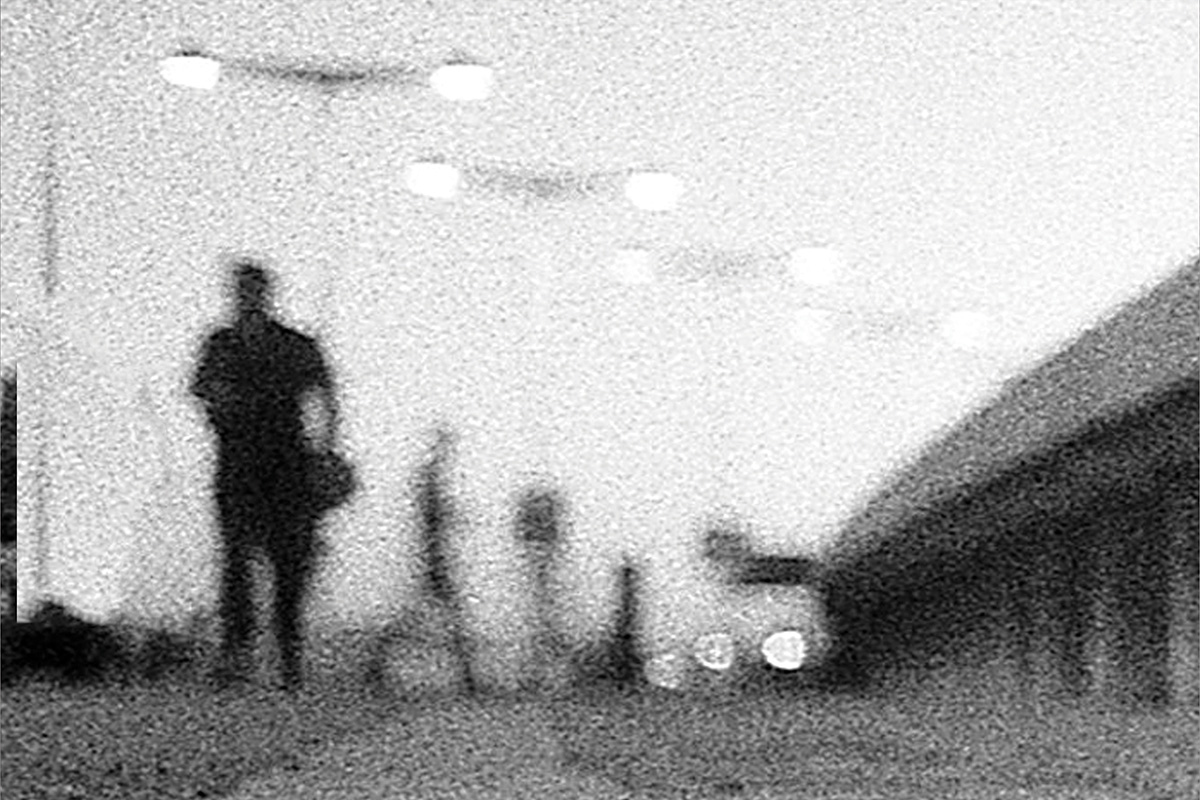
Juan Desteract
Souviens-toi
Experimental video | mov | black and white | 1:31 | France, Argentina | 2022
La persistance d’une image fatidique et le besoin de s'y accrocher impliquent le dédoublement d’un souvenir. Ce dernier se trouve ainsi suspendu entre les multiples versions d’un même évènement, entre les représentations d’un passé et un présent déjà vécu, entre figuration et abstraction, entre mouvement et immobilité, entre film et photographie. Des impressions intrusives d'autres vies se superposent au souvenir, nous exposant ainsi à une réalité surveillée où nous nous demandons qui voit et que voir.
Juan Desteract est né à Saint-Germain-en-Laye (France) en 1997. Il vit actuellement à Buenos Aires, en Argentine. Il a étudié le design graphique à l’Université de Buenos Aires. Il a poursuivi sa formation en photographie et arts visuels au cours de divers séminaires, ateliers et résidences artistiques à Buenos Aires. Parallèlement, il s'est formé en écriture, composition musicale puis en improvisation musicale. A partir de 2021, il participe à des expositions collectives dans des espaces artistiques et des musées d'art contemporain en Argentine, au Chili, Uruguay, Espagne et en France. Son travail associe des disciplines diverses telles que la post-photographie, l'audiovisuel expérimental, le design graphique et l'improvisation musicale, en se focalisant sur certains traits distinctifs du cinéma structurel et du réemploi d’archives. Depuis 2020, Juan travaille dans le domaine du design graphique en tant que Professeur à l’Université de Buenos Aires et en tant que graphiste au Musée d'art moderne de Buenos Aires.
Sandrine Deumier
Catalogue : 2026Le Jardin d'acclimatation | Experimental VR | 0 | color | 0:0 | France | 2023
Sandrine Deumier
Le Jardin d'acclimatation
Experimental VR | 0 | color | 0:0 | France | 2023
At first glance presenting itself as a mysterious botanical garden shrouded in mist and dotted with interactive panels and tactile objects, Le Jardin d’acclimatation is an anthropised space, shaped by human perception and systems of thought. As the viewer explores this virtual environment — freely accessible yet offering only limited visibility — it gradually branches into adjacent spaces, opening onto other modes of visualisation. These successive stages reveal the enigmatic complexity of plant organisms in interaction with their environments. Each layer of perception functions as a threshold to be crossed, highlighting in particular the often-invisible complexity of root systems and mycorrhizal processes, as well as the diverse modes of nutrition, communication and interaction (associations, symbioses, mutual aid, and not least predation strategies). Available through three distinct yet complementary modes (exploratory, intuitive–emotional, and scientific), the journey through this botanical garden unfolds into multiple parallel scenes, expanding our perceptual capacities and allowing for a deeper understanding of the plant world. Original music: Sonia Paço-Rocchia A work produced at the public agricultural institution Chartres–La Saussaye as part of a partnership between the DRAAF, the DRAC, and the Centre–Val de Loire Region (France).
Sandrine Deumier is a multidisciplinary artist working across performance, poetry and video art. Her practice explores post-futurist themes through the development of aesthetic forms shaped by digital imaginaries. Driven by an interest in digital storytelling and immersive artistic experiences, she has spent several years developing poetic and visual fictions centred on speculative visions of the living world. Ecological concerns and imagined futures lie at the heart of her research. Her work focuses primarily on how new technologies might allow us to imagine alternative ways of inhabiting the world from an animist perspective — one in which the preservation of natural balances takes precedence over predation, accumulation and limitless growth.
Lili Reynaud Dewar
Catalogue : 2017TGMFS | Experimental doc. | 4k | color | 36:0 | France, USA | 2016
Lili Reynaud Dewar
TGMFS
Experimental doc. | 4k | color | 36:0 | France, USA | 2016
"In her first film, the artist brings together elements of science fiction and rap with discourses on emancipation and colonialism in an installation that pushes against the boundaries of its space. A film that depicts the before and during of a performance in Memphis, Tennessee. On a shell-shaped concrete stage a woman recites excerpts from a socialist-feminist manifesto while four local stand-up-comedians improvise alongside her. This chorus of voices is further accompanied by a noise-musician. Reynaud Dewar chose the place of the performance for its particularly controversial and diverse background. The metropolis, situated on the Mississippi delta, is on the border between the affluent Midwest and the poorer South of the United States. This city was the epicenter of the American slave trade and the later Civil Rights Movement. The latter culminated in the Sanitation Strike of 1968, which was further intensified by the assassination of Martin Luther King, Jr. after he took an active role in these demonstrations. Memphis is also an iconic location in the history of American music in the United States. It is widely known for its Blues music and as the final resting place of Elvis Presley. In more recent years, the city has evolved into a vital center of rap culture in the US. Working alongside the local comedians, Reynaud Dewar uses this specific historical and socio-political backdrop to negotiate the appropriation of a certain cult object. A central element of the film is the so-called grill—a jewelry worn over the teeth, which is typically made of precious metals. In Black music, especially in rap and hip-hop, the grill functions as a sort of relic and status symbol. Through her adoption of these objects as a white, European artist, Reynaud Dewar knowingly raises provocative questions of cultural appropriation, impression, and transformation, as well as the legitimization of these acts. The connective link in this work is Donna Haraway’s 1985 text, A Cyborg Manifesto. This treatise—a feminist essay that employs, albeit in a partly ironical sense, a cyborg as a metaphor for the dissolution of conservative borders between humans, machines, and animals—propagandizes a state of chimerical fusion in which normative categories like class, gender, or race are discarded.
Bertrand Dezoteux
Catalogue : 2018Picasso Land | Animation | hdv | color | 11:6 | France | 2015
Bertrand Dezoteux
Picasso Land
Animation | hdv | color | 11:6 | France | 2015
Ce projet a pour origine le célèbre ballet Parade (1917), dont les costumes et décors avaient été créés par Picasso, sur un texte de Cocteau, musique de Satie, et chorégraphie de Massine. En 1980, ce monument de l’avant-garde européenne est adapté à la télévision par Jean-Christophe Averty, réalisateur héritier du surréalisme, et pionnier de la technique d’incrustation (chroma key) en France. Picasso Land tente de perpétuer cet esprit d’avant garde en proposant un troisième opus, en 3D. Décors et personnages ont été modélisés à partir de peintures et sculptures de Picasso, formant un petit peuple hétéroclite et dansant. Pour mettre en action ces corps singuliers, leur donner vie, une chorégraphie a été créée en collaboration avec le danseur Yaïr Barelli. Il a développé un vocabulaire de gestes, de pas et d’attitudes qui furent numérisés puis injectés dans les personnages. Cette relecture de l’oeuvre de Picasso dévoile un “ Pays “, qui se construirait d’oeuvre en oeuvre, qui aurait ses propres moeurs, sa culture, son territoire.
Bertrand Dezoteux. Né en 1982, formé au Fresnoy Studio national des arts contemporains, il développe sa pratique autour de nouvelles formes audiovisuelles. À la frontière du documentaire, de la fiction et de la science-fiction, ses films s’inspirent des logiciels de modélisation 3D, pour créer des objets visuels hybrides. Il réalise ainsi “ Le Corso ” en 2008, “ L`Histoire de France en 3D ” en 2012, “ Animal Glisse ” en 2015, “ Picasso Land ” en 2016 ou encore "Super-règne" en 2017. Présenté en France et à l’étranger, le travail de B. Dezoteux interroge notre rapport aux autres, au travail ou au quotidien, notre imaginaire du futur et notre désir d’ailleurs. En 2015, il est lauréat du prix Audi talents awards pour le projet “ En attendant Mars ”, mené en collaboration avec l`Observatoire de l`espace du CNES (Centre national d`études spatiales). En 2017, l’artiste a été exposé au Palais de Tokyo (Paris) et à la Station (Nice), ses films ont été montrés au New York Film Festival et au Toronto International Film Festival. En mars 2018, il est programmé au théâtre des Amandiers (Nanterre) ; en avril, la galerie Édouard Manet (Gennevilliers) lui consacre une exposition personnelle.
Catalogue : 2009Le Corso | Animation | 0 | color | 14:0 | France | 2008
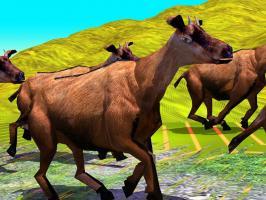
Bertrand Dezoteux
Le Corso
Animation | 0 | color | 14:0 | France | 2008
At the beginning of this project, I wanted to make a rural video, without any anthropomorphism, as if it had been shot from the point of view of an animal. This statement is obviously stupid (animals don?t make either video, or 3D), and the movie becomes similar to an animal documentary. The camera seems to be held by an amateur, who tries to follow the furious race of the impassive creatures. Their characters are taken from different races (cattle, cat, insect), but these beasts seem to observe some rules, some rituals. Their behaviours deal with primitive intelligence (getting in a circle and turning round), and their reactions are linked with our recent past (the Creutzfeldt-Jakob disease).
Born in 1982 in Bayonne (France), Bertrand Dezoteux is a young basque artist who repeatedly leaves his native country. He first moved to Angoulême (2001 ? 2003) to study the graphic novel. Then, in 2004, he learned the rigorous art of Korean Painting in Pusan. He finally got his diploma (DNSEP) in Strasbourg in 2006. There, he worked with the Bulgarian artist Plamen Dejanoff, who commissioned 5 collages. These pictures were exhibited in The MuMok of Vienna, then in the gallery La Chaufferie, in Strasbourg, where one of the collages mysteriously disappeared. Bertrand Dezoteux finished his studies in Le Fresnoy, studio national des arts contemporains. He currently continues to observe, as an amateur anthropologist, the behaviours of the homo digitalus.
Catalogue : 2008Roubaix 3000 | Fiction | | color | 9:0 | France | 2007
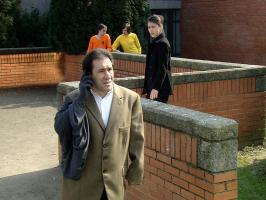
Bertrand Dezoteux
Roubaix 3000
Fiction | | color | 9:0 | France | 2007
Roubaix 3000 est un film de famille d?anticipation politique. Je suis descendu dans le Sud avec un magnétophone pour enregistrer mes proches. J?ai récolté là-bas beaucoup de voix et dès mon retour dans le Nord, je les ai entendues des heures durant. J?ai tenté d?adopter une écoute flottante, et de sélectionner les éléments paraboliques, ceux qui semblaient au premier abord anodins, mais qui au final dessinaient une géopolitique familiale. Il apparaît alors une structure où les générations cohabitent et évoluent avec leurs préoccupations et leurs langages singuliers. Le montage fut mon outil d?écriture. J?élaborai un scénario par l?agencement des paroles, l?assemblage des phonèmes, le chevauchement des interjections. Il m?importe que les voix ne soient pas jouées, qu?elles soient spontanées, rythmées, que les dialogues ne soient pas écrits pour être interprétés. Il y a deux forces qui luttent dans ce système de conception : les voix d?un côté sont souveraines et indomptables, obéissant aux lois de leurs propriétaires. De l?autre côté, les acteurs, tous Roubaisiens et amateurs, tentent par le play-back de jouer leur partition, de donner corps à ces paroles qui ne sont pas les leurs. Ces deux expressions se rassemblent lors du tournage, à Roubaix, où l?architecture est riche en collages, en assemblages, en greffes, en citations antiques.
Né le 22 février 1982 à Bayonne (64), Bertrand Dezoteux est un jeune artiste basque qui n?a cessé dès lors de s?éloigner de sa terre natale. Il s?exile à Angoulême pour étudier la narration graphique entre 2001 et 2003, puis migre en 2004 à Pusan, en Corée du Sud, où il apprend les exigences et la rigueur de la peinture Coréenne. Enfin, il achève sa scolarité à Strasbourg pour passer son DNSEP en juin 2006. En ce moment étudiant au Fresnoy, il vit et travaille à Roubaix, où il a réalisé le projet « Roubaix 3000 » (www.roubaix3000.com).
Caroline Déodat
Catalogue : 2023Sous le ciel des fétiches | Experimental doc. | 0 | color | 16:53 | France, Mauritius | 2023
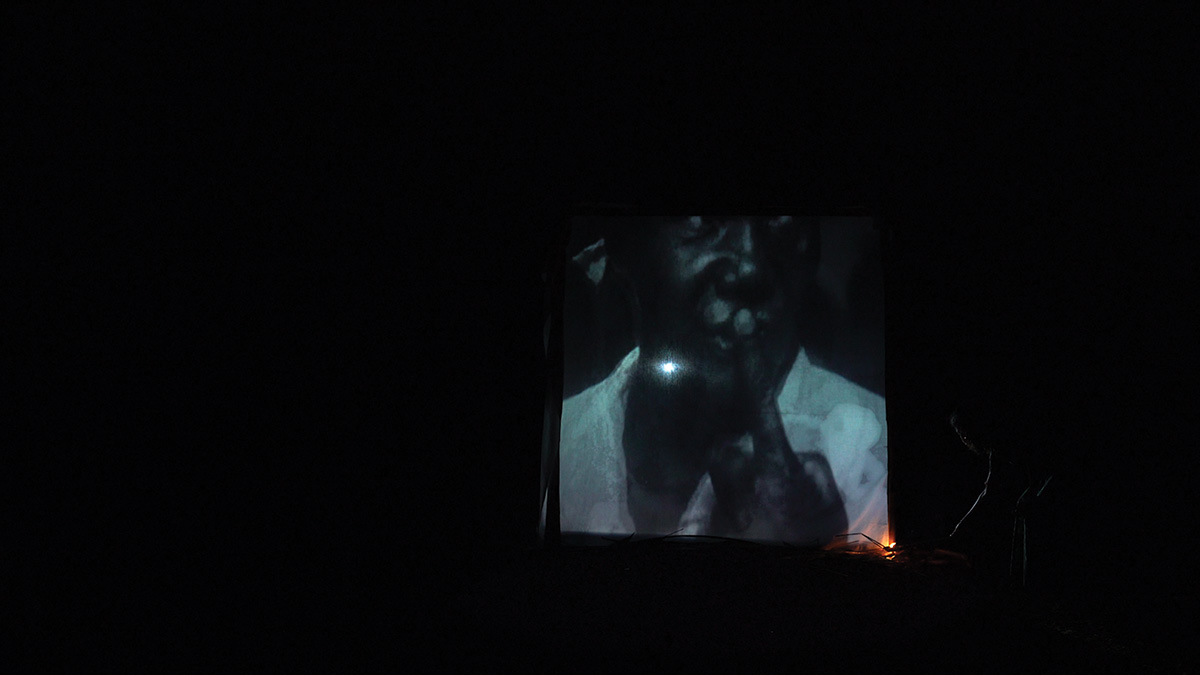
Caroline Déodat
Sous le ciel des fétiches
Experimental doc. | 0 | color | 16:53 | France, Mauritius | 2023
Sous le ciel des fétiches répond à la difficulté de montrer l’ubiquité des archives coloniales dans l’histoire du séga mauricien. Née pendant la colonisation et l’esclavage au sein de communautés de fugitif.ves, cette pratique de danse et de poésie chantée survit aujourd’hui principalement sur les scènes touristiques des hôtels. Travaillant la relation d’emprise avec le passé colonial, le film réinvestit les spectres d’un regard qui hante. Comment projeter – littéralement faire sortir de soi – le récit de nos agresseurs ?
Caroline Déodat est artiste et chercheure. Docteure en anthropologie de l'EHESS, elle a été formée à l'École des Beaux-Arts de Lyon dans le cadre du post-diplôme Art. Par le biais de films et d'installations, elle explore les dimensions spectrales de l'image en mouvement dans une circulation entre fiction et ethnographie. De ses obsessions pour les processus d'archivage et d'aliénation, l'histoire et les mythes de la violence, elle exhume des récits par la convocation de mémoires hantologiques, d'archives en différé et d'images orales. Son travail a été montré au Musée Reina Sofía à Madrid, dans les Résonances de la Biennale d'art contemporain de Lyon, à la Fondation Sandretto Re Rebaudengo à Turin, et prochainement au Salon de Montrouge, au Ji.hlava International Documentary Film Festival à Prague, au Magasin à Grenoble et à l'IFAN à Dakar.
Bertram Dhellemmes, Ines BIRKHAN
Catalogue : 2007Klang zur Stille zum Klang | Experimental fiction | dv | color | 64:0 | France, Austria | 2005
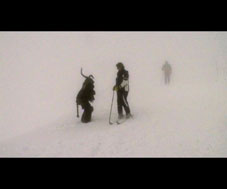
Bertram Dhellemmes, Ines BIRKHAN
Klang zur Stille zum Klang
Experimental fiction | dv | color | 64:0 | France, Austria | 2005
In "Klang zur Stille zum Klang" ? a composite storytelling video installation ? are superimposed the meeting of the she-Krampus (a legendary character from the Austrian Alps), the new inhabitants of the mountains, and the tribulations of Tchumuki, a rebel employee of the silence factory...
Choreographer, dancer, and writer, Ines Birkhan, and stage and video director, musician, and art critic Bertram Dhellemmes, have collaborated on several projects since 2002 and are currently co-directing the Berlin-based performance company Real Dance Super Sentai. Being both multimedia artists, their collaboration has led them to the field of multimedia, with a predilection for the exploration of alternative narrative, on stage or in videos. Amongst their recent works are: "den kreisrunden Todengwalzer tanzen", which so far consists of three forms of an on-going project; a video installation, a dance performance, and a book by Ines Bikhan - released in Peter Lang Verlag, March 2007.
Ra Di Martino
Catalogue : 2026Kant Can't Chorus | Experimental VR | 4k | color | 16:0 | Italy | 2025
Ra Di Martino
Kant Can't Chorus
Experimental VR | 4k | color | 16:0 | Italy | 2025
The video Kant Can't (2024) centres on the oneiric portrait of a group of characters who inhabit an imaginary landscape. Astronauts fleeing from an immense figure of a woman in the process of trying to trample them, hands that emerge like enormous archaeological ruins and gigantic insects that burst onto the scene, form the scenario of an escape into the absurd. The relationship with consciousness becomes an experiential journey, in which reality is magnified by our means of perception. In the video, the primary protagonist is an astronaut who has managed to escape his fate, yet then finds himself in various situations, in a succession of scenarios not unlike those of a video game.
Rä di Martino (Rome, 1975) studied in London, where she earned an MFA from the Slade School of Art. With the Premio New York, she received a scholarship to Columbia University. Her work has been exhibited internationally in museums and film festivals, including: MoMA-PS1 and Artists Space, New York; Tate Modern, London; MCA, Chicago; Palazzo Grassi, Venice; Museion, Bolzano; Magasin, Grenoble; the Busan Biennale; Manifesta 7; Kino der Kunst, Munich; Transmediale, Berlin. At the 2014 Venice Film Festival, she presented the medium-length documentary The Show MAS Go On, winning the Gillo Pontecorvo Award, the SIAE Award, and a Nastro d'Argento; the 2018 Festival presented her feature film Controfigura. In 2019, she opened the exhibition Afterall at Mattatoio - Palaexpo in Rome and at Kunst Halle Sankt Gallen. In 2022, she held a retrospective exhibition at Forte Belvedere in Florence and a solo exhibition at Torre Matta in Otranto with an installation on Carmelo Bene's archive. She opened her solo show Electric Whispers at BAC, Beirut Art Center and Fotografia Europea, Reggio Emilia in 2025.
Catalogue : 2017Authentic News of Invisible Things | Video | hdv | color and b&w | 5:30 | Italy | 2014
Ra Di Martino
Authentic News of Invisible Things
Video | hdv | color and b&w | 5:30 | Italy | 2014
Authentic News of Invisible Things explores mechanisms of pretence and make-believe by focusing on military camouflage. Camouflage was first used at the end of the nineteenth century to help prevent armies from being detected by enemy forces. Colours and materials are used to conceal uniforms, vehicles and equipment and make them look like something else. Camouflage also extends to the construction of mock military equipment to confuse and deceive the enemy, generating a situation of alert. Examples of this include dummy tanks constructed using wooden structures or panels of chipboard, and then painted or decorated. Used already in the Second World War and to a lesser extent in WWI, these are still widespread: in the 1990s fibreglass models produced by an Italian company were successfully deployed in the Gulf War. Iveco Defence Vehicle (Iveco DV), part of the Fiat Group, headquartered in Bolzano, makes vehicles for military and civil defence purposes. The company receives orders directly from the Ministry of Defence to produce these vehicles and the production process and all related information is therefore covered by the Official Secrets Act. However once these vehicles are decommissioned they are no longer regarded as classified and can be used by the film industry, for marketing, entertainment and by private individuals. Indeed there are numerous collectors and theme parks in possession of working vehicles, also from foreign armies, that can be hired or tried out to get a taste of military life. It is therefore easy for the film industry to get hold of functioning, but unarmed vehicles, for use in battle scenes. The situation is therefore paradoxically subverted: real tanks enter the world of make-believe, while mock-ups are deployed in real-life conflict situations. Authentic News of Invisible Things sits on the dividing line between fact and fiction, with documentary-style scenes and a theatrical re-enactment. With the support of historic photographs and film footage from public and private collections, the video becomes a sort of short journey through the paradoxes of both history and contemporary life. One of the two key scenes of the video, which mingles performance art and cinema, has been shot in the historic city centre of Bolzano. A real-life, working tank drives through the city centre in broad daylight, with no prior warning to stage a paradox. Various cameramen hidden among the public filmed the action and people`s reactions. The other scene is a recreation of an archive photograph of a group of French civilians gathered around a wooden dummy tank made by the Germans and abandoned in Lille, the 20th of October 1918.
Rä di Martino (Rome, 1975) studied in London where she’s graduated with an MFA at the Slade School of Art and after spending a few years in New York she moved back to Italy. Her practice explores the passage of time, as well as the discrepancies that differentiate epic narratives from lived experiences. Her films have been shown at the Venice film Festival, Locarno film festival and Torino International Film Festivals amongst other and in Istitutions and museums such as: Moma-PS1, NY; Tate Modern, London; MCA Chicago; Museion, Bozen; Palazzo Grassi, Venice; Artists Space, New York. In 2014/15 she has participated to the Venice Film festival 2014, winning the SIAE award and Gillo Pontecorvo award, and a Nastro d’argento for best docufilm.
Catalogue : 2010August 2008 | Art vidéo | dv | color | 5:0 | Italy, USA | 2009
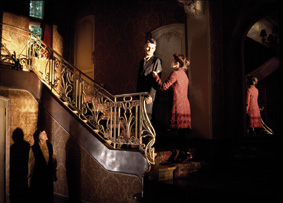
Ra Di Martino
August 2008
Art vidéo | dv | color | 5:0 | Italy, USA | 2009
Two actors create a sort of tableau-vivant; a frozen moment from what seems a movie from the 50`s. Suddenly they start singing the news (all from August 2008 headlines) in a minimalistic chorus.
Rä di Martino was born in Rome in 1975; she lived in London since 1997 where she?s graduated with an MFA at the Slade School of Art. In 2005 she moved to New York. Her work focuses on film and video work and has participated to many international film festivals. Since 2005, she has broadly exhibited her work. Her exhibition include : Media Art Festival Friesland 07; Dallas Video Festival 07; Unclassifiable @ Malmö Film Festival 07; Pesaro Film Festival 07; Trieste Film Festival 07; Kassel Documentary Film&Video Fest 08; Turin Gay&Lesbian Film Festival 08; Manifesta 7, 2008; Italics at Palazzo Grassi and the Quadriennale in Rome, Galleria Maze, Turin, PS1, NY; the Busan Biennale in Korea, the Turin Triennale T1, MACRO, Rome, Montevideo/Times; Based Arts, Amsterdam. Her films and videos have been shown in many festivals around the world including: KunstFilmBiennale, Cologne & Munich 09; Impakt Video Art Festival, Utrecht 09; EMAF, Osnabrueck European Video Art Festival, Germany 09. In 2009 she had a solo show at Monitor Gallery, Rome; CAV Foundation, Coimbra Portugal, and in Vilnius for Artscape, Vilnius Cultural Capital of Europe, Vartaj Gallery.
Catalogue : 2009The Red Shoes | Art vidéo | 16mm | color | 4:0 | Italy | 2007
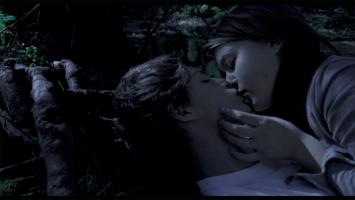
Ra Di Martino
The Red Shoes
Art vidéo | 16mm | color | 4:0 | Italy | 2007
The video recalls a story and resembles something - a hazy memory or dream - from somewhere. The film appears to be part of a feature film, perhaps one that we have seen, but can`t quite remember the name. It can be read as found footage, a fake found footage.
Rä di Martino was born in Rome in 1975; she lived in London since 1997 where she?s graduated with an MFA at the Slade School of Art and a BA from Chelsea College of Art. In 2005 she moved to New York with a bursary at Columbia University and the Italian Cultural Institute. Her work focuses on film and video work and has participated to many International film festivals. This summer she?ll be participating to MANIFESTA7; AIM at the Bronx Museum; Italics at Palazzo Grassi. In February she opened a solo show at galleria maze in Turin and has participated to the exhibition Senso Unico at PS1 earlier in the year. She has also shown at the Busan Biennale in Korea, the Turin Triennale T1, MACRO, Rome, MONTEVIDEO/Times Based Arts, Amsterdam; Artists Space, NY; GAM Galleria d?Arte Moderna, Bologna; Locarno Film Festival; Viper Basel; Impakt Film&Video Festival; Kassel Video & Doc Festival; New York Underground Film Festival; Transmediale, Berlin. She was awarded a residency at Art Omi in 2006, Artists in The Market Place at bronx Museum 2007-8 and Fondazione Ratti in 2005.
Alessio Di Zio
Catalogue : 2013Fanteria Cavalleggeri | Experimental doc. | | color | 24:0 | Italy | 2011
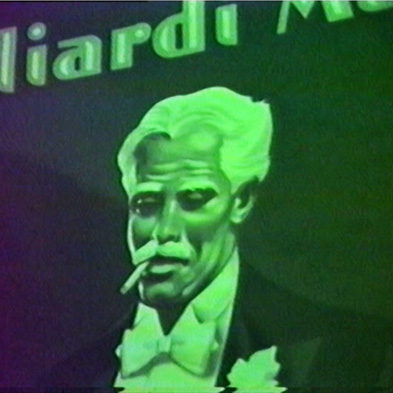
Alessio Di Zio
Fanteria Cavalleggeri
Experimental doc. | | color | 24:0 | Italy | 2011
A documentary on the recreational circles that appeared in the interwar period in a provincial town. The film observes what happens and everything that surrounds a group made up entirely of senior citizens who are absolutely determined to enjoy themselves. The settings evoke memories of a past that may have never actually existed, with common and recurring aesthetics in which wartime images frequently play a part, and locations steeped in visual images that are perhaps slightly stereotyped.
Alessio Di Zio is graduated from high school. He produced "Far Away", "Casimiro's Tales", "The Park", "The Pleasure", "Infantry Cavalry", "Swinging Horsese", "Roberto Pellegrinaggio", "2.15". A group of portraits of people, landscapes and circumstances from his birthpalce. His short films have screend in many film festivals and exhibitions including l'Arcipelago Film Festival, Venice Film Festival, Minneapolis Film Festival, Circuito Off, Monfilmfest, Premio Marzocco and CinemAvvenire, receiving several awards. Working with musical band Micro b, he made the videoclip "Euforica", which was the winner at the Sottodiciotto (under eighteen) Film Festival in Turin.
Miguel Dias, --
Francisco Dias
Catalogue : 2023Litoral | Fiction | 4k | color | 13:9 | Portugal | 2023
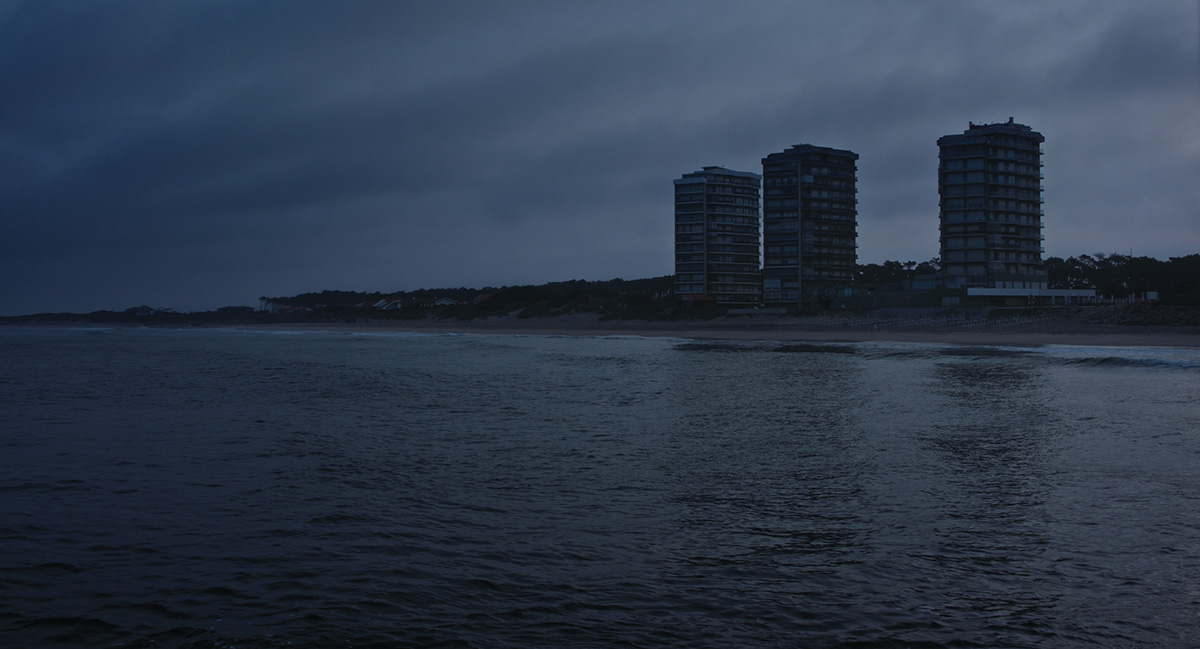
Francisco Dias
Litoral
Fiction | 4k | color | 13:9 | Portugal | 2023
One winter night, the sea threatens once again the tower block where two neighbours live. The next day, their children come to prompt them to leave everything behind.
Francisco Dias was born in 1999 in Porto, Portugal. In 2019, he lived and studied in Norway. In 2020, he completed the Bachelor's in Sound and Image and in 2023 the Master's in Cinema at Universidade Católica Portuguesa, having obtained scholarships for both courses. Rooted in his culture and personal experiences, his films focus on coming of age, human relationships and landscape. "I Don't Like 5 PM", winner of the Take One! competition at Curtas Vila do Conde International Film Festival, and "Coast" stand out in his filmography.
Ruben Diaz, Cristina Dominguez
Sebastian Diaz Morales
Catalogue : 2016Suspension | Video | hdv | color | 12:0 | Argentina, Netherlands | 2015
Sebastian Diaz Morales
Suspension
Video | hdv | color | 12:0 | Argentina, Netherlands | 2015
The mind was dreaming. The world was its dream. Jorge Luis Borges It is in the nature of men to be absorbed by the future as if magnetized by timeless gravity, falling deeper and deeper into their own humanity. And if in Walter Benjamin’s angelus novus we picture his gaze of horror, shaken and frightened by what he sees as he gazes upon the past, the man in his fall evinces unperturbed passivity towards the future. As in a dream state, through that suspended fall the man’s mind is a container holding past, present and future in a single consciousness. It is in this construction, as in a dream, in his mind, where man envisions and shapes the world. Out there, there may be no more than void, and the fall may be eternal. Perhaps this is the reason why we recurrently dream about falling. Perhaps falling isn’t a dream at all—perhaps falling is what’s real.
Sebastian Diaz Morales was born in the Patagonian region of Argentina, in 1975 and studied both in Argentina at the Universidad del cine de Antín and at the Rijksakademie in Amsterdam. Morales’s video work blurs fiction and documentary genres and has been screened extensively at film festivals as well as in a gallery context. With its spliced footage and stills and jumbled observations, his work follows the tradition of Latin-American narrative film. Morales plays with the structure of narrative within his work, typically documenting and constructing journeys that explore social and political concerns. His work has been exhibited widely at many prominent venues—such as the Tate Modern, London; Centre Pompidou; Stedelijk Museum and De Appel, Amsterdam; Art in General, New York City; Ludwin Museum, Budapest; Bienale Sao Pablo; Biennale of Sydney; Miro Foundation, Barcelona; MUDAM, Luxemburg; and the Calouste Gulbenkian Foundation, Lisbon—and is the permanent collections of the Centre Pompidou; Tate Modern; Fundacion Jumex, Mexico; Sandretto Foundation, Torino; Sammlung-Goetz, Munich; and the Fundacion de Arte Moderna, Museo Berardo, Lisbon. In 2009 he was awarded with a Guggenheim Fellowship.
Sebastian Diaz Morales
Catalogue : 2015Insight | Video | hdv | color | 11:31 | Argentina | 2012
Sebastian Diaz Morales
Insight
Video | hdv | color | 11:31 | Argentina | 2012
Insight is the total abstraction. A carefully assembled film-crew appears like a tableau vivant facing the viewer. Then suddenly, they shatter- an analogy of breaking through the surface to expose the simulation - a mirror slowly explodes into a thousand pieces. Filmed in beautifully rendered high definition Insight is a tribute to the camera obscuras of old mingled with a critical spirit directed towards the mass media today. Regarded as a phenomenon brought about by a world lacking distinction between real and simulacra, Diaz Morales borrows media industry tactics to expose and undermine. Revealing rather than concealing his methods allows for a moment of realisation to occur. As the pieces of glass crumble into tiny galaxies, context is deconstructed and the universalising tendency of Diaz Morales' practise literally portrayed. With timeless grace the artist contemplates the nature of existence. (text Nathalie Levi) We look at a film crew; the film crew is watching us. Cinema as a mirror of reality that becomes fiction. Or is it vice versa? A world with a mirror image, one that can be accessed by crossing the mirror’s surface. Indeed, within the realm of fiction, mirrors provide characters and readers alike with a gateway to a different world. Interaction with that new environment, be it purely fantastic or disturbingly didactic, pushes one to expand one’s horizons and reconsider the concept of a real world.